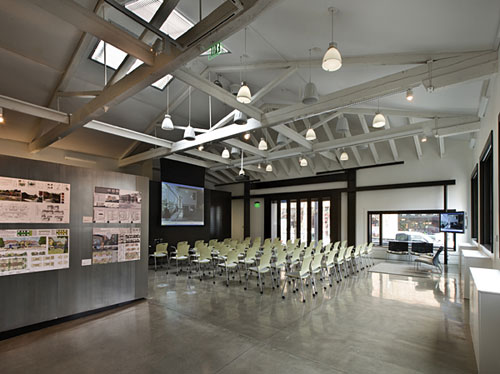Renovating an Historic Structure for LEED Platinum Certification
According to the LEED requirements, alternative commuting transportation credits are available for buildings that have the intent to reduce pollution and land development impacts from conventional automobile use for commuting trips. The requirements to earn credits are based on providing people with transportation choices which result in a reduction in the number of commuting round trips made by regular building occupants using single-occupant, conventionally-powered, and conventionally-fueled vehicles. For the purposes of this credit, alternative transportation includes mass transit. Since Portland has an efficient system of bus lines and light rail, Portland AIA wanted its new headquarters to be near these mass transit options.
 |
Flyash concrete, which is a byproduct of coal combustion, was used for the floor of the Portland AIA's Center for Architecture and helped earn a carbon reduction benefit. Photo courtesy of Michael Mathers |
After narrowing its search in the Pearl District, the Portland AIA chapter came upon a vacant 10,000-square foot building built in the 1880s that was originally used as a livery stable for horses, and was most recently an art gallery. It is thought to be the oldest surviving structure in the Pearl District.
Located in the heart of the district, the building also had the benefit of being located directly on the Portland Streetcar line, one of the city's light rail options that connect the outer suburbs to the inner city. The fortunate location meant staff and visitors could take public transportation to the Center and literally be within a few yards of the building at the nearest stop. Bike racks encourage bikers to commute to work and provide a secure location to park.
In addition, the building met many of the association's other goals mentioned previously: it featured street level access, an open layout, and had the potential to be configured into a flexible space.
Reusing Materials
The Portland AIA was determined to use as much of the original building configuration and its materials in the redesign and remodel as possible. Starting with the shell, which is iconic in the area and conveys an old-Portland feel with its single story that sits amongst new hi-rises, the architectural team used the original envelope as a guide to work within and kept as many interior components as possible. In addition, materials with recycled content were regionally sourced when possible to keep the project local and sustainable. As Scott adds, "the most sustainable material is the one you don't use."
After years of use and a slope that pointed toward the city's sewer system, the structure's floor needed to be redone and leveled for use as a functional office environment. Rather than using traditional Portland cement, the architects specified high-volume flyash concrete, which is a reusable byproduct of coal-fired electric generating plants.
"The floor was sloped and had a step with one-third of the area at a lower level," said Scott. "We demolished much of the floor and leveled it off with flyash concrete. The idea was to have the floor function with a dual purpose of structural strength and an attractive finish. It turned out beautifully and has functioned well."
Scott said that by putting flyash in place of some of the typical cement content, the Center achieved a carbon reduction benefit. According to www.sustainablesources.com, flyash concrete is defined in cement and concrete terminology as "the finely divided residue resulting from the combustion of ground or powdered coal, which is transported from the firebox through the boiler by flue gases."
Flyash is one of three general types of coal combustion byproducts (CCBP's). The use of these byproducts offers environmental advantages by diverting the material from the wastestream, reducing the energy investment in processing virgin materials, conserving virgin materials, and reducing pollution.
Although flyash offers environmental advantages, it also improves the performance and quality of concrete. Flyash affects the plastic properties of concrete by improving workability, reducing water demand, reducing segregation and bleeding, and lowering heat of hydration. Flyash increases strength, reduces permeability, reduces corrosion of reinforcing steel, increases sulphate resistance, and reduces alkali-aggregate reaction. Flyash reaches its maximum strength more slowly than concrete made with only Portland cement. The techniques for working with this type of concrete are standard for the industry and did not impact the budget of a job.
By using the maximum amount of flyash in the floor concrete, the Center's architects turned what was once a major polluter into one of the most eco-friendly buildings in Portland.









